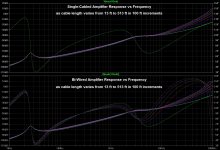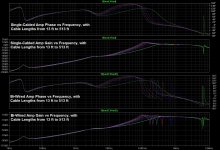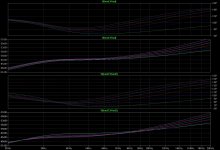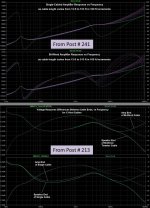Frank, unless you have something useful, why not give it a rest? Please? You've presented no evidence, no tests, no sims, no measurements, no documented listening session. Nothing but conjecture.
You've made your viewpoint very clear. That's fine, but that's all it is at the moment. Please drop it until you have something more solid so that we can get on it. Thanks.
You've made your viewpoint very clear. That's fine, but that's all it is at the moment. Please drop it until you have something more solid so that we can get on it. Thanks.
I always prefer email. Drop me a line if you come back to town.
I didn't even notice that I could send one, from here. I see it now.
Thanks. I certainly will let you know. It had been quite a few years since I made the trek but it was a lot of fun with a lot left un-done so it might not be as long before I'm back again. I'm about six hours south and somewhat east of there, about 20 minutes north of I-64.
Fair enough ...You've made your viewpoint very clear. That's fine, but that's all it is at the moment. Please drop it until you have something more solid so that we can get on it. Thanks.
My 2p
My take on this, is down to which crossover performs best, the one in your speaker, or the one in the amplifier/receiver that you use to drive it.
Loudspeakers generally have a passive crossover which electrically filters the audio signal into high, mid and low frequencies to present to their respective drivers in the box. These are designed to work exactly with the set-up in the speaker box and should work correctly with any amplifier setup.
Bi/wiring uses two amplifiers in the receiver which each get their signal from channels in the receiver which in a true bi amp set-up only get the frequency range that the speaker can handle, which can be set up in the receiver. This potentially will work better if set up correctly, as it depends on you knowing the properties of each individual driver in the box. However if not set up correctly it will sound worse than the way the speaker is set up with its own crossover.
Either way it's all subjective, if your ears like a particular set-up then that's the one that's right for you.
To answer the OP, in a bi wire set-up, is the crossover not bypassed? for one of the drivers at least?
My take on this, is down to which crossover performs best, the one in your speaker, or the one in the amplifier/receiver that you use to drive it.
Loudspeakers generally have a passive crossover which electrically filters the audio signal into high, mid and low frequencies to present to their respective drivers in the box. These are designed to work exactly with the set-up in the speaker box and should work correctly with any amplifier setup.
Bi/wiring uses two amplifiers in the receiver which each get their signal from channels in the receiver which in a true bi amp set-up only get the frequency range that the speaker can handle, which can be set up in the receiver. This potentially will work better if set up correctly, as it depends on you knowing the properties of each individual driver in the box. However if not set up correctly it will sound worse than the way the speaker is set up with its own crossover.
Either way it's all subjective, if your ears like a particular set-up then that's the one that's right for you.
To answer the OP, in a bi wire set-up, is the crossover not bypassed? for one of the drivers at least?
In addition to an engineering background, I have tried and tested this extensively. There is no difference at all. None. If you hear anything, it's the added effect of the single cable rather than two in parallel. Try a single cable of a thicker gauge and this disappears. Note I said IF.If you are referring to me, I made a very narrow statement within an intentionally narrow context, and I stand by that statement in that context.
I never said it never works for anyone ever.
I also encourage people to go ahead and try for themselves, though I urge them not to spend any significant money on the 'experiment'. I also acknowledged that THEY might like what they hear. But liking what you hear, doesn't necessarily make it true.
And I stand by that statement.
As to the central question which, intentionally or not, was, what does the CROSSOVER do different, the answer is nothing. The crossover does nothing different. And I stand by that statement.
Steve/bluewizard
False. What you have described is an active filtered, bi-amplified setup. It bears no relation to bi-wiring a passive speaker as is being discussed.My take on this, is down to which crossover performs best, the one in your speaker, or the one in the amplifier/receiver that you use to drive it.
Loudspeakers generally have a passive crossover which electrically filters the audio signal into high, mid and low frequencies to present to their respective drivers in the box. These are designed to work exactly with the set-up in the speaker box and should work correctly with any amplifier setup.
Bi/wiring uses two amplifiers in the receiver which each get their signal from channels in the receiver which in a true bi amp set-up only get the frequency range that the speaker can handle, which can be set up in the receiver. This potentially will work better if set up correctly, as it depends on you knowing the properties of each individual driver in the box. However if not set up correctly it will sound worse than the way the speaker is set up with its own crossover.
Either way it's all subjective, if your ears like a particular set-up then that's the one that's right for you.
To answer the OP, in a bi wire set-up, is the crossover not bypassed? for one of the drivers at least?
From my POV the fundamental problem in this thread is the title: it should be "What does the amplifier do differently when you bi-wire" ...
Shouldn't that be -
"What does the SPEAKER do differently when you Bi-Wire?"
Steve/bluewizard
...
...
Bi/wiring uses two amplifiers in the receiver...
BI-Wiring = Two wires, or more accurately, two wire pairs.
BI-Amping = Two amps, with one wire pair to each amp.
I think you are referring to Bi-Amping with Active Crossovers. Most would feel this is the only true Bi-Amping arrangement. But it takes a pretty substantial bank of technical knowledge, and involved an element of danger (usually cause by ham-fisted drunken friends). Plus are pretty large pile of money for the Active Crossovers, especially if you want the most flexibility in the crossovers.
I think to do it up right, you would need an Active Crossover that gave you control of the crossover frequency, the crossover slopes, phase or polarity of each channel, and the amplitude of each crossover channel. Many moderately expensive Active Crossovers have a fixed Slope, and only allow you to vary the frequency.
Most would agree, assuming you know how to set it up, and assuming you can keep your drunken friends from twiddling with the knobs, that this does have some true benefit.
Some would even say it constitutes the most ideal setup. However, to have the technical know-how, the cash on hand, and the ability to control other people it a tall order.
Ideal as this may be, one can not deny that there are some very fantastic Passive speakers out there. Speakers that have a much lower hurtle to using them.
Steve/bluewizard
Some plots at the amplifier output terminals are attached.
The plots in post#241 are supposed to show the response on the amplifier side of the cables right?
They are showing > 50dB response deviations.
Back in Post#213 you plotted what I think is the same parameters and only showed ~ 1dB response deviations.
What am I missing?
Attachments
I see audio as dealing with a system, with everything that implies. There is never just the speaker, creating a certain quality in the sound, there is the latter in combination with everything else - what you hear is the result of that totality ...Shouldn't that be -
"What does the SPEAKER do differently when you Bi-Wire?"
Steve/bluewizard
BI-Wiring = Two wires, or more accurately, two wire pairs.
BI-Amping = Two amps, with one wire pair to each amp.
I think you are referring to Bi-Amping with Active Crossovers. Most would feel this is the only true Bi-Amping arrangement. But it takes a pretty substantial bank of technical knowledge, and involved an element of danger (usually cause by ham-fisted drunken friends). Plus are pretty large pile of money for the Active Crossovers, especially if you want the most flexibility in the crossovers.
I think to do it up right, you would need an Active Crossover that gave you control of the crossover frequency, the crossover slopes, phase or polarity of each channel, and the amplitude of each crossover channel. Many moderately expensive Active Crossovers have a fixed Slope, and only allow you to vary the frequency.
Most would agree, assuming you know how to set it up, and assuming you can keep your drunken friends from twiddling with the knobs, that this does have some true benefit.
Some would even say it constitutes the most ideal setup. However, to have the technical know-how, the cash on hand, and the ability to control other people it a tall order.
Ideal as this may be, one can not deny that there are some very fantastic Passive speakers out there. Speakers that have a much lower hurtle to using them.
Steve/bluewizard
Actually, the crossovers are not expensive. This is the DIY forum! The extra amps can be. With DIY, you can select freq, slope, Q, phase, delay, whatever you want. ( delay is tricky)
What it takes is the time, effort, knowledge and skill/luck to design a speaker system. I have done some active, and for the sub/main it is the only practical way to go, ( go ahead, price a 300 mH coil ). I tried digital, aka DCX, but I find I have no where exhausted learning about basic two-way passive speakers to need to move to bi-amping. I agree, there are some very fine ones out there. I think my last pair are pretty darn good. I did not waste an extra set of banana plugs on the back. I run a single wire pair. 16 ga zip.
Ok I see. So yeah what is the point in bi wiring only to add more copper to the path between amplifier and speaker. You can achieve much the same by using a higher gauge speaker cable imo. Capacitance and crosstalk only become an issue over much longer distances but you are still getting the same signal at the driver end and the crossover works exactly the same way.
I always took bi wiring to mean bi amping as the jumper on the back of the speaker separates the high and low part of the speaker for which you then need to apply the proper signals to get the best out of the driver.
I always took bi wiring to mean bi amping as the jumper on the back of the speaker separates the high and low part of the speaker for which you then need to apply the proper signals to get the best out of the driver.
Thanks Captain Obvious. Any more startling revelations?I see audio as dealing with a system, with everything that implies. There is never just the speaker, creating a certain quality in the sound, there is the latter in combination with everything else - what you hear is the result of that totality ...
Well, what's also 'startling' is that people pay lip service to such ideas, and then immediately ditch them when it comes to the practicalities. This is along the lines of "the electronic side is all done and dusted, any vaguely competent setup will do, the great coalface is honing the best, with great precision, out of those stinking speakers, and landscaping your room to an inch of its plasterboard to make it tolerable ... "
Last edited:
Well I measured some slight differences and posted them. So bi-wire can make a difference and you've seen one of them. Whether that difference can be duplicated by simply using a larger gauge cable, I don't know. Probably.
"Amplifier-Loudspeaker Interfacing", Greiner, R.A., JAES vol. 28, no. 5 May 1980, "Cables and the Amp Speaker Interface", Greiner, R.A., Audio, Aug 1989, addendum Nov 1989, and "Effects of cable, Loudspeaker and Amplifier Interactions", Davis, Fred E., JAES, vol. 39, no. 6 Jun 1991. Your differences (assuming that the measurement differences were greater than the error bars) aren't because of biwiring.
Thanks Captain Obvious. Any more startling revelations?
Don't get trolled. Encouraging gas release helps no-one.
- Status
- This old topic is closed. If you want to reopen this topic, contact a moderator using the "Report Post" button.
- Home
- Loudspeakers
- Multi-Way
- What does the crossover do differently when you bi-wire?



